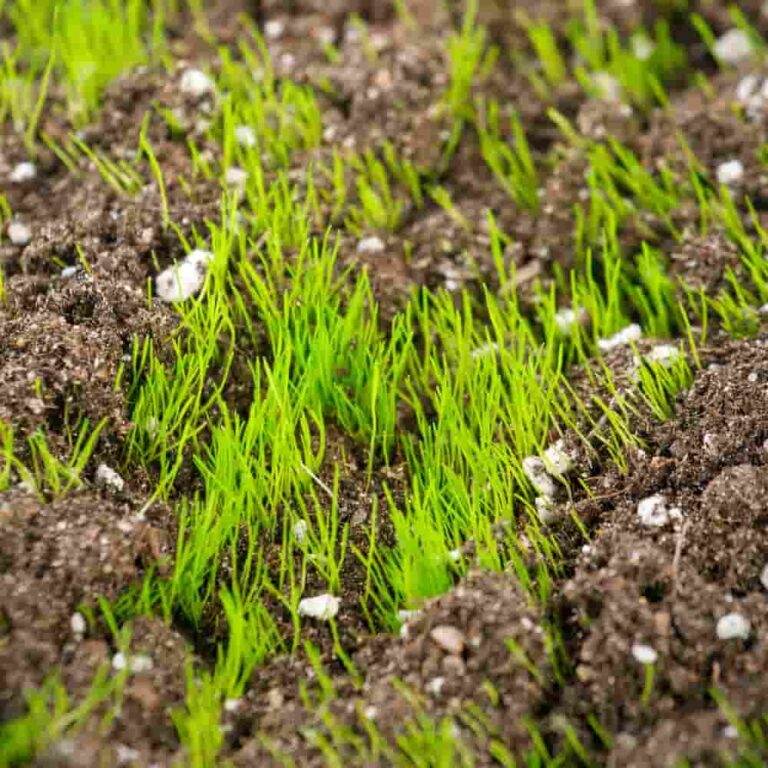How to Kill Moss in Lawn
Grasses thrive in favorable conditions like good aeration, proper watering, timely fertilization, and have thin thatch on the topsoil. Such grasses produce a thick, dark green, healthy, and aesthetically appealing lawn.
However, moss loves a poorly watered, badly-aerated, shaded lawn. It will take over areas with thin grass. It’s the last thing you want in your pristine yard, and it has to go.
You can kill moss using two simple ways.
- Dish soap and baking soda
- Chemical herbicides that specifically target moss.
We’ll learn methods to get rid of moss and keep moss from invading your lawn.
Is moss in the lawn really bad?
Moss growing on the lawn isn’t really bad because it can’t kill the grass. Also, it makes an okay ground cover when you let it grow intentionally for that purpose. However, it appears yellowish or green and feels spongy when walked on, destroying the appealing aesthetic of the lawn when it’s invasive and unwanted.
Moss is a sign of weak grass and possibly unhealthy soils. Address these weaknesses as soon as you spot them.
How to get rid of moss on your lawn?
There are two surefire ways to get rid of moss from the lawn – using a dish soap solution or a moss killer.
Use a dish soap mixture.
Moss flourishes in dumpy places by drawing water from the soil. Dish soap kills it by preventing it from absorbing moisture.
Dish soap mixture should be applied when the grass is moist, and there should be no rain forecast in the next 24 hours.
To kill moss using dish soap, you will need water, a squirt bottle, or a garden sprayer. Here’s how to kill moss from the lawn using dish soap solution.
- Mow the lawn, ensuring the grass is a few centimeters above the top of the moss. Cutting grass short helps the solution penetrate and contact the moss quickly.
- Mix 2 ounces of dish soap with 1 gallon of water for small areas infested with the moss. Pour the solution into a squirt bottle. Mix 4 ounces of dish soap with 2 gallons of water per 1000 square feet of lawn for larger areas.
- Spot spray the solution closely on the moss and drench thoroughly. After some time, the moss will dry, turn brown or orange, and die.
- Rake the browns spotted areas of dead moss and dispose of them by stacking or burying them. Do not add dead moss to a compost pile, as this can increase the chances of regrowing. If new moss regrows, reapply the solution until the moss is gone.
- Wait for 3 to 4 days after removing the dead moss, then overseed the patches left with new grass seeds.
Add iron sulfate moss killer.
Iron sulfate feeds grass with nutrients while slowly killing moss from the lawn by drying it.
Note: Check the day’s weather forecast. There should be no rain forecast in the next 12 hours after applying iron sulfate.
Here’s how to kill moss using iron sulfate moss killer:
- Mow the grass a few centimeters above the moss for easy contact between the iron sulfate and the moss.
- Rake the excess moss. For highly infested areas, it’s vital to rake twice in two phases for maximum removal. Raking the moss before adding the iron sulfate moss killer ensures that the intruders are removed beforehand. Stand from one corner of the lawn, rake the moss in a back and forth direction, and repeat a second time in a direction opposite to the one you started.
- Mix the granules of the iron sulfate in the proportions directed by the manufacturer and spray the solution on the lawn. If you’re using powder moss killer, apply the product using a spreader then water the area.
Iron sulfate acts fast, and you might see the moss turning black after one hour. Wait for about 7 to 10 days for the product to completely kill the moss and turn them black or brown.
- Rake the remaining black dead moss using a dethatcher or a rake. You can also use a power rake to remove it while also scarifying the lawn. Dispose of the dead moss in an isolated area or bury it.
- Overseed the bare spots left by dead moss to encourage turf growth and help the lawn recover quickly from the stress.
When should I remove moss from my lawn?
The best time to remove moss from your lawn is late summer or early fall for cool-season grasses and late spring or early summer for warm-season grasses.
At this time, the grass is entering its active growth period and would recover quickly from the stress.
Ensure you remove moss before seeding your lawn.
Will grass grow back after moss?
Grass will only grow after you remove moss if you correct the poor conditions that encouraged moss’ growth.
Reseeding or resoding, and fertilizing the lawn reduce the chances for moss to regrow. Healthy grass in an area exposed to sunlight is a terrible environment for moss.
Does aeration help with moss?
Aeration is a great way to keep moss from flourishing on your lawn.
Aeration breaks compact soils by creating small holes that allow water, air, and nutrients to penetrate and reach the grassroots.
Aeration keeps the topsoil dry and ensures the ground is well-drained to reduce water saturation.
Good circulation of air, water, and fertilizer keeps moss from thriving.
Preventive tips; keep moss from growing/recurring.
Although moss is harmless, its presence on lawns signifies unhealthy conditions that kill the grass. These poor conditions are overly shaded areas, poor drainage, compact soil, acidic soil, and close mowing.
Moss will regrow if you kill it and retain the conditions that favor its growth. You will need preventative measures that keep your lawn healthy to keep moss at bay completely.
Cut extending branches to allow more sunlight penetration
Moss thrives in dark areas with no sunlight. Turfs require 4 to 6 hours of sun exposure. Inadequate exposure time creates an excellent opportunity for moss to grow. Shrubs and trees growing near the lawn grow long branches that sometimes cast their shadows or block sun rays from reaching the lawn grass.
To ensure most sun reaches the grass to favor their growth and discourage moss from growing, cut nearby branches of trees and shrubs.
2. Dig trenches and water only when the grass is in need
Waterlogged soils create a moist environment that encourages moss to grow. Compact soils and poor water drainage are the primary causes of waterlogging.
Dig small trenches to direct the excess standing water to the main trench. The soil dries up when the excess water is drained, discouraging the moss from growing.
Apart from the rain, overwatering is another major cause of waterlogging. The best way to avoid overwatering the lawn is to irrigate only when the grass needs water.
Check for signs such as footprints on the grass or discoloring to know when to apply water to the lawn.
3. Aerate compact soil
Compact soils prevent air, nutrients, and water from reaching the grassroots. Aerate compact soils to allow the water to sip in to favor grass growth and discourage moss from growing. Use a core aerator to remove plugs of soil or a solid tine aerator to punch small holes to create space for water passage.
4. Add lime to more acidic soils.
Grasses prefer less acidic or neutral soils of pH range 6.0 to 7.2. Overly acidic soils stress the grass and stifle growth. Unsurprisingly, moss thrives in these acidic soils.
Adding lime to acidic soils raises their pH and makes them more alkaline.
Carry out a soil test to determine the soil pH before adding lime. Add lime to highly acidic soils to make them more favorable to grass growth.
Alkaline soil discourages moss growth.
5. Mow grass at the correct mowing height
Leaving grass uncut for long encourages weeds to grow. Cutting grass too short scalps the lawn and creates bares spots that encourage moss invasion. Moss is also common in lawns with thin grass blades.
The best method to avoid grass overgrowth is frequently mowing at the correct height. Use the one-third mowing rule with a sharp bladed mower. This practice leaves no bare spots that allow moss to grow.
References
Clemson Cooperative Extension: MOSS AND ALGAE CONTROL IN LAWNS.
University of Maryland: Lawn Aeration.



![When to Fertilize New Sod [Guide for St. Augustine, Bermuda + Zoysia]](https://lawnmodel.com/wp-content/uploads/2023/01/When-to-Fertilize-New-Sod-Guide-for-St.-Augustine-Bermuda-Zoysia-768x576.jpg)

